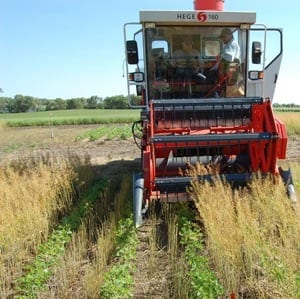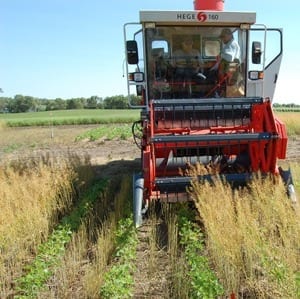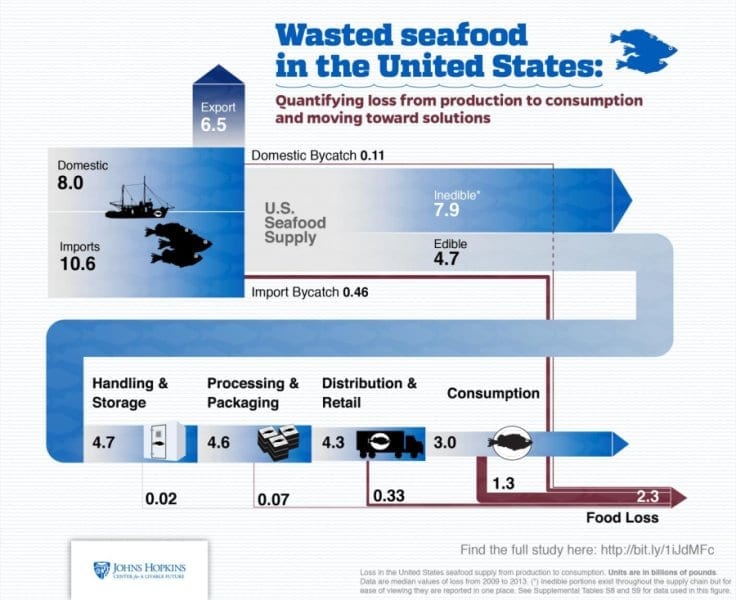
In the United States, federal mandates to produce more renewable fuels, especially biofuels, have led to a growing debate: Should fuel or food grow on arable land? Recent research shows farmers can successfully, and sustainably, grow both.
Russ Gesch, a plant physiologist with the USDA Soil Conservation Research Lab in Morris, Minnesota, found encouraging results when growing Camelina sativa with soybean in the Midwest.
Camelina is a member of the mustard family and an emerging biofuel crop. It is well suited as a cover crop in the Midwest. “Finding any annual crop that will survive the [Midwest] winters is pretty difficult,” says Gesch, “but winter camelina does that and it has a short enough growing season to allow farmers to grow a second crop after it during the summer.”
Additionally, in the upper Midwest, soils need to retain enough rainwater for multiple crops in one growing season. Gesch and his colleagues measured water use of two systems of dual-cropping using camelina and soybean. They compared it with a more typical soybean field at the Swan Lake Research Farm near Morris, MN.
First, researchers planted camelina at the end of September. From there growing methods differed. In double-cropping, soybean enters the field after the camelina harvest in June or July. Relay-cropping, however, overlaps the crops’ time. Soybeans grow between rows of camelina in April or May before the camelina plants mature and flower.
The benefits were numerous. Relay-cropping actually used less water than double-cropping the two plants. Camelina plants have shallow roots and a short growing season, which means they don’t use much water. “Other cover crops, like rye, use a lot more water than does camelina,” says Gesch.
Conveniently, the extra water use during dual-cropping takes place in the spring. “We tend to have an excess of moisture in the soil in the spring from the melting snow pack,” says Gesch. Growing camelina as a winter cover crop can help farmers take advantage of spring’s extra moisture.
Read more: Food or fuel? How about both?
The Latest on: Dual-cropping
[google_news title=”” keyword=”Dual-cropping” num_posts=”10″ blurb_length=”0″ show_thumb=”left”]
via Google News
The Latest on: Dual-cropping
- Gardener's 'easy' basil pruning trick will 'double you harvest' in no timeon April 30, 2024 at 2:40 am
There’s nothing more rewarding than growing a thriving basil plant, but gardening guru Jamie Walton has shared a clever hack to boost your harvest - and it's easier than you think ...
- Former crop centre reboots as Western Crop Innovationon April 29, 2024 at 11:51 am
The Field Crop Development Centre at Lacombe, Alta., has a new name and identity that reflects a broadening focus.
- Tracey Boakye: Actress Flaunts Her Cleavage In A Double Breasted Zipper Top And Stunning Skortson April 29, 2024 at 6:39 am
Award-winning Ghanaian actress Tracey Boakye has brought back a timeless fashion trend as she rocks a skintight top and matching skirt shorts in a viral video.
- Double cropping: A year-round strategy for wheat, soybean farmerson April 28, 2024 at 10:45 am
West-central Illinois farmers see benefits of double cropping that keeps land in constant use with increased yields and profits.
- DJI Agras T50 and T25 Expand Aerial Crop Protection Capabilitieson April 25, 2024 at 6:00 am
DJI, the world leader in civilian drones and creative camera technology, today announced the international launch of the Agras T50 and Agras T25 drones. Building on the popular Agras drone line, the ...
- Global double cropping could handicap American farmerson April 24, 2024 at 6:03 pm
An ag economist says cropland expansion in other countries could put U.S. farmers at a disadvantage. Ohio State University professor emeritus Carl Zulauf tells Brownfield about 400 million acres of ...
- How do crop–livestock systems switch to agricultural green development in the Baiyangdian Basin?on April 22, 2024 at 11:12 am
Excessive nitrogen input into agriculture systems has caused environmental problems such as atmospheric pollution, loss of biodiversity and degradation of water. Meanwhile, the development of ...
- Why meth labs are cropping up in Greater Noidaon April 22, 2024 at 3:35 am
A recent raid on 17 April resulted in the capture of four Nigerian nationals and the confiscation of 26.67 kg of drugs valued at Rs 100 crore. Investigations reveal that foreign drug peddlers are choo ...
- Crop Trust seeks more funding to protect global seed diversityon April 20, 2024 at 10:19 am
RABAT, April 20 (Reuters) - Crop Trust, which works to preserve crop bio-diversity, needs to more than double its $300 million endowment fund to be able to support seed banks across the world ...
- Crop Trust Seeks More Funding to Protect Global Seed Diversityon April 20, 2024 at 10:19 am
RABAT (Reuters) - Crop Trust, which works to preserve crop bio-diversity, needs to more than double its $300 million endowment fund to be able to support seed banks across the world, Executive ...
via Bing News











